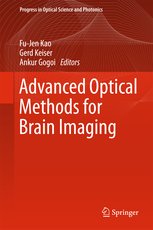Recent book on Advanced Optical Methods for Brain Imaging

This book highlights the rapidly developing field of advanced optical methods for structural and functional brain imaging. As is known, the brain is the most poorly understood organ of a living body. It is indeed the most complex structure in the known universe and, thus, mapping of the brain has become one of the most exciting frontlines of contemporary research. Starting from the fundamentals of the brain, neurons and synapses, this book presents a streamlined and focused coverage of the core principles, theoretical and experimental approaches, and state-of-the-art applications of most of the currently used imaging methods in brain research. It presents contributions from international leaders on different photonics-based brain imaging modalities and techniques. Included are comprehensive descriptions of many of the technology driven spectacular advances made over the past few years that have allowed novel insights of the structural and functional details of neurons.
Invited Review manuscript in METHODS is now online
The invited review manuscript entitled “Polarization Resolved Second Harmonic Microscopy” has been accepted in the Elsevier journal ‘Methods’ and is now published online. In this invited review manuscript, the working principles of the polarization resolving techniques and the corresponding implements of second harmonic (SH) microscopy are elucidated, with focus on Stokes vector based polarimetry. Notably, SH microscopy has proven to be a powerful imaging modality over the past years due to its intrinsic advantages as a multiphoton process with endogenous contrast specificity, which allows pinhole-less optical sectioning, non-invasive observation, deep tissue penetration, and the possibility of easier signal detection at visible wavelengths. Depending on the relative orientation between the polarization of the incoming light and the second-order susceptibility of non-centrosymmetric structures, SH microscopy provides the unique capacity to probe the absolute molecular structure of a broad variety of biological tissues without the necessity for additional labeling. In addition, SH microscopy, when coupled with polarimetry, provides clear and in-depth insights on the details of molecular orientation and structural symmetry. An overview of the advancements on SH anisotropy measurements have been presented in the manuscript. Specifically, the recent progresses on the following three topics in polarization resolved SH microscopy have been addressed, which include Stokes vector resolving for imaging molecular structure and orientation, 3-D structural chirality by SH circular dichroism, and correlation with fluorescence lifetime imaging (FLIM) for in vivo wound healing diagnosis. The potentials and challenges for future researches in exploring complex biological tissues were also discussed in the manuscript.
Read our paper online here.


